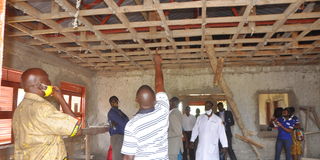Why ceilings collapse

Oyam District technical monitoring team, together with officials from Transparency international Uganda, inspect a ceiling, which caved in late last year at the newly upgraded Iceme Health centre IV. PHOTO/Stephen Otage
What you need to know:
From the age of the building to weight and material, different factors can cause the collapse of a ceiling. Our experts explain why your ceiling may collapse.
In mid-March 2021, a ceiling of one of the commercial buildings along Kampala road collapsed, with two of the casualities succumbing to injuries much later.
According to police reports, the collapse of the building was suspected to be caused by age of the building that had taken long without renovation.
Joseph Oryang, an engineer notes that when most structures or houses ( whether residential or commercial) have stood for long, they need expert technical examination and inspection to find out any weakness or cracks that could have developed in certain parts such as ceilings, overtime.
Sometimes these buildings just require a little bit of maintenance and strengthening some areas, say during periodic building renovations or modifications that were not in the original plan, to prevent unforeseeable occurrences such as ceiling collapses.
“Some buildings were set up at a time when there was not much regulation. The builders could have done a lot of decorative or shoddy work on the outside that it is hard to notice what was done within the ceiling body. The only way to curb collapses is through regular maintenance,” Oryang advises.
Materials used
The only materials used to construct ceilings are metal and wood. These, more so wood, deteriorates when it has been eaten up by insects or termites, while metal could also be exposed to rust, thereby becoming weak and eventually giving in to collapse.
“Sometimes the metal or wood work could have been poorly constructed. If you have a wooden ceiling framework and the ceiling was plastered, it will be heavy if it was not adequately supported. If the metals were not treated, it rusts overtime.
These may not collapse immediately but overtime because of wear and tear factors,” Oryang adds.
The weight of ceiling load
There are cases where the ceiling load is too much for the support structure to hold.
For instance, there are scenarios where centralised air conditioning ducts are attached to a concrete slab underneath the ceiling, where the attachment was done using screws and wall plugs. With years, the ceiling structure, Oryang explains, becomes too heavy for the screws and wall plugs that it (ceiling) pulls them out of the concrete and it collapses.
Also, if the air conditioning system is running under the concrete slab, if the air conditioning collapses, the ceiling will be brought down as well.
Emmanuel Kyeyune, a builder explains that if the support structure of the ceiling was poorly built from the beginning, it will collapse with time.
“There are technicians who widen gaps within the ceiling timber and use a lot of sand and cement that acts as a load against the timber. As years go by, the sand and cement weight becomes heavy for the side supporting structures to support and eventually collapses,” Kyeyune explains, adding that music speakers or systems that produce strong vibrations against an already weak structure could also cause a collapse.
Preventing ceiling collapse
Oryang and Kyeyune agree that structural ceiling collapse can be prevented by paying attention to structural designs. Unfortunately, many building or home owners think ceilings are minor aspects and ignore consulting an engineer for advice while trying to save costs.
This is wrong because the engineer determines the design of ceiling to build after understanding and observing the sorrounding support structures.
“People often get away with it only to experience a ceiling collapse that in most cases claims lives.
“A ceiling must be professionally and technically secured just like the foundation should be firm because it (ceiling) carries a load that is always connected to a supporting structure,” Kyeyune concludes.
Testing ceiling strength
Architectural finishes are among the most elegant and subtle improvements you can make to your home. Polyurethane or hollow wood mouldings add shape, style, and texture to a room without taking away from the main living-area focus. The most beautiful architectural finishes usually mount directly in the upper corners and to the ceiling itself. Of course, this means you will be mounting your finishes directly to the ceiling in order to install them into place.
Before you get started, it’s important to know whether your ceiling is strong enough to support architectural finishes. Even though polyurethane and hollow wood are very lightweight, they still weigh a reasonable amount, mostly in large pieces. Most ceilings can support these finishes but you don’t want to be surprised if your home’s ceiling is too weak and at risk of giving way.
Source: worthingtonmillwork.com
To ask the expert, email us at [email protected]




